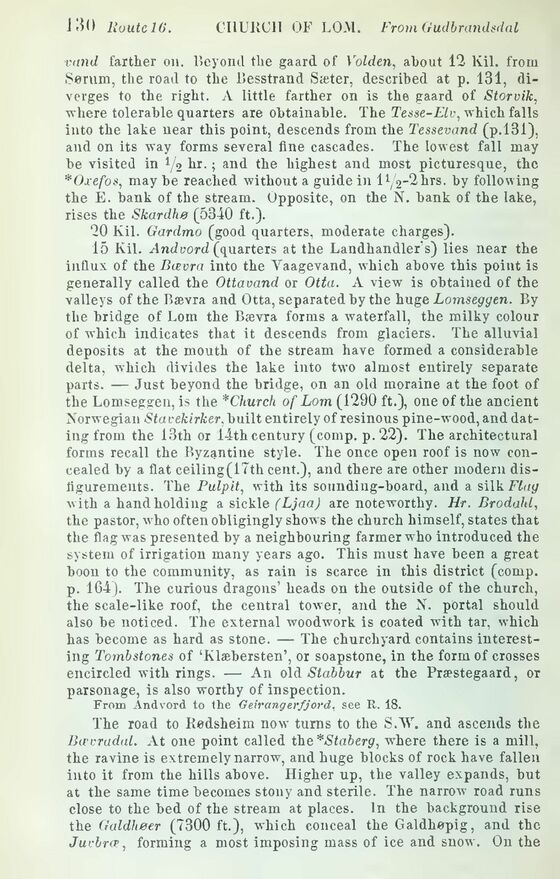
Full resolution (JPEG) - On this page / på denna sida - Norway - Pages ...

<< prev. page << föreg. sida << >> nästa sida >> next page >>
Below is the raw OCR text
from the above scanned image.
Do you see an error? Proofread the page now!
Här nedan syns maskintolkade texten från faksimilbilden ovan.
Ser du något fel? Korrekturläs sidan nu!
This page has never been proofread. / Denna sida har aldrig korrekturlästs.
vand farther on. Beyond the gaard of Volden, about 12 Kil. from
Serum, the road to the Besstrand Sæter, described at p. 131,
diverges to the right. A little farther on is the gaard of Storvik,
where tolerable quarters are obtainable. The Tesse-Elv, which falls
into the lake near this point, descends from the Tessevand (p.131),
and on its way forms several fine cascades. The lowest fall may
be visited in 1 o hr.; and the highest and most picturesque, the
*Oxefos, may be reached without a guide in iKWhrs. by following
the E. bank of the stream. Opposite, on the N. bank of the lake,
rises the Skardhe> (5340 ft.).
20 Kil. Gardmo (good quarters, moderate charges).
15 Kil. Andvord (quarters at the Landhandler’s) lies near the
influx of the Bævra into the Yaagevand, which above this point is
generally called the Ottavand or Otta. A view is obtained of the
valleys of the Bævra and Otta, separated by the huge Lomseggen. By
the bridge of Lom the Bævra forms a waterfall, the milky colour
of which indicates that it descends from glaciers. The alluvial
deposits at the mouth of the stream have formed a considerable
delta, which divides the lake into two almost entirely separate
parts. — Just beyond the bridge, on an old moraine at the foot of
the Lomseggen, is the * Church of Lom (1290 ft.), one of the ancient
Norwegian Stavekirker, built entirely of resinous pine-wood, and
dating from the 13th or 14th century (comp. p. 22). The architectural
forms recall the Byzantine style. The once open roof is now
concealed by a flat ceiling(17th cent.), and there are other modern
disfigurements. The Pulpit, with its sounding-board, and a silk Flag
with a hand holding a sickle (Ljaa) are noteworthy. Hr. Brodahl,
the pastor, who often obligingly shows the church himself, states that
the flag was presented by a neighbouring farmer who introduced the
system of irrigation many years ago. This must have been a great
boon to the community, as rain is scarce in this district (comp,
p. 164). The curious dragons’ heads on the outside of the church,
the scale-like roof, the central tower, and the N. portal should
also be noticed. The external woodwork is coated with tar, which
has become as hard as stone. — The churchyard contains
interesting Tombstones of ‘Klæbersten’, or soapstone, in the form of crosses
encircled with rings. — An old Stabbur at the Præstegaard, or
parsonage, is also worthy of inspection.
From Andvord to the Geiranger fjord, see R. 18.
The road to Redsheim now turns to the S.4V. and ascends the
Bwvradal. At one point called the*Nhi6erp, where there is a mill,
the ravine is extremely narrow, and huge blocks of rock have fallen
into it from the hills above. Higher up, the valley expands, but
at the same time becomes stony and sterile. The narrow road runs
close to the bed of the stream at places. In the background rise
the Galdheer (7300 ft.), which conceal the Galdhepig, and the
Jurbrcr, forming a most imposing mass of ice and snow. On the
<< prev. page << föreg. sida << >> nästa sida >> next page >>